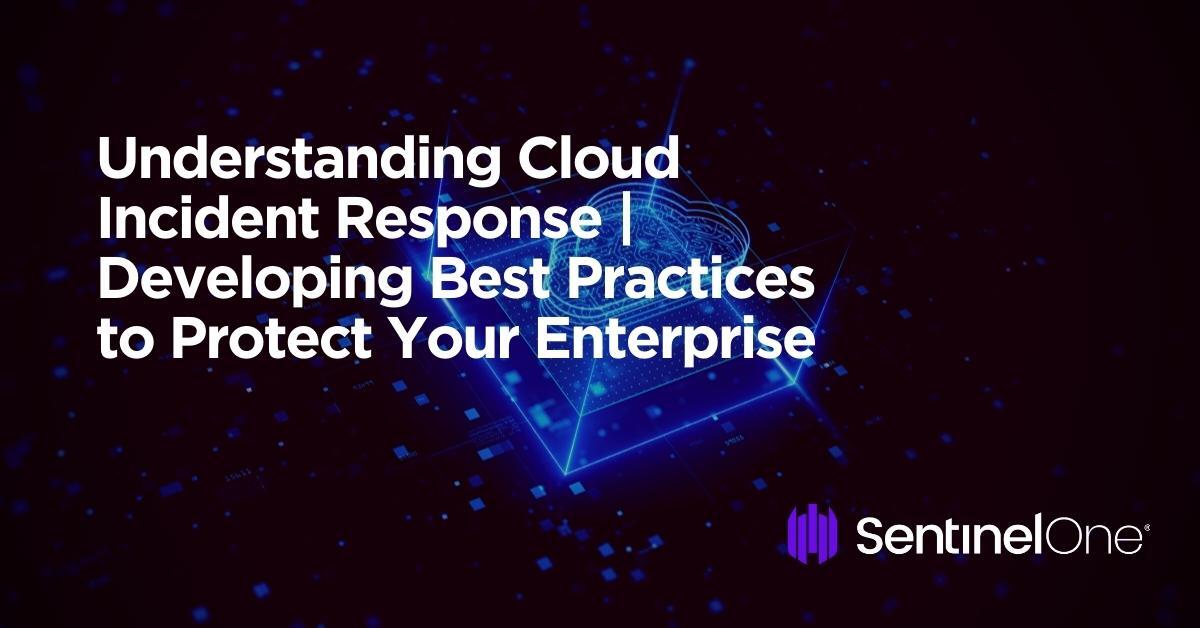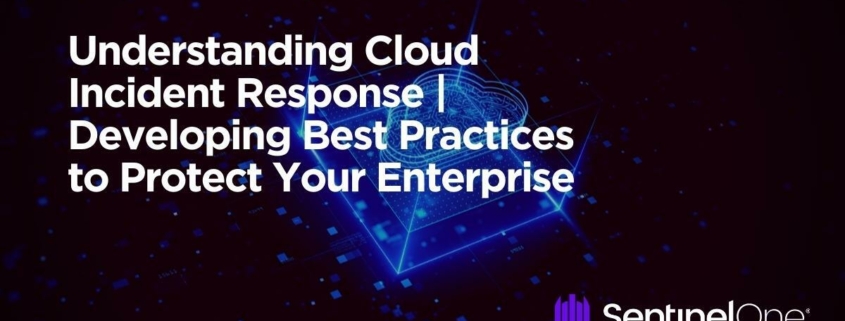Understanding Cloud Incident Response | Developing Best Practices to Protect Your Enterprise
Enterprise leaders responsible for managing incidents in the cloud are widely encouraged to craft their security strategy through a proactive approach, but in current times while contending with sophisticated threat actors, malware, and tools, what does a proactive approach really mean?
As more enterprises adopt cloud technology for its scalability, flexibility, and cost-efficiency, threat actors see these reasons as opportunities to exploit and attack. As much as enterprises are moving towards cloud as part of their digital transformations, all industries are also seeing a growing rise in cloud data breaches, ransomware attacks, and insider threats.
This post covers the key best practices that enterprise leaders and security teams can implement to set an effective cloud-based incident response plan in place, minimizing the harm caused by security incidents and accelerating the time to recovery.

Defining Cloud Incident Response
Over the last few decades, acceleration of cloud adoption has evolved incident response (IR). This global shift represents new challenges for security leaders, especially in terms of data volume, accessibility, and how fast threats can develop within cloud infrastructures.
Modern enterprises that have fully moved to the cloud or embraced a hybrid cloud adoption strategy face complex cloud environments. Consisting of components, virtualization, storage, workloads, cloud management software and more, the cloud presents defenders with much to secure.
Cloud IR addresses all of these unique risks to the cloud and frames how enterprise leaders can identify, detain, mitigate, and respond to threats in such a rapidly changing environment. Unlike traditional IR strategies, Cloud IR requires a more nuanced approach that can account for the way cloud platforms are managed, how data is stored and accessed, and the dynamic nature of the cloud itself.
- Managing the Cloud Platform – Each cloud platform typically has a single control center known as the administrative console, or management plane. This console allows admin users to create new identities, deploy services and updates, as well as manage configurations affecting all hosted assets within the cloud. Since this console is a converging point between the infrastructure and cloud user identities, it is a highly lucrative ‘keys to the kingdom’ target for attack by threat actors.
- Understanding Data in the Cloud – Clouds hold data, apps, and components in external servers which, if not configured correctly or kept up to date, can serve threat actors as a main diving board to all connected assets. Other than external threats, internal threats such as misconfigurations and vulnerabilities must also be considered, since cloud networks are known for their large size and level of complexity.
- Handling a Dynamic Cloud – Modern cloud platforms are very dynamic, meaning security teams will need to remain agile and have full visibility of all cloud services and apps to secure it. The sheer volume in the cloud alone is enough of a risk in that it can slow down threat hunting, triage, and incident investigation processes if teams are not intimately familiar with their environment.
Recognizing A Growing Need for Cloud-Specific Response
Cloud computing has introduced new security challenges and threats that require enterprises to take a different approach to security, compared to traditional on-premises infrastructure. What’s needed in today’s digital landscape to protect the cloud is a robust incident response plan capable of focusing on cloud-specific risks while also providing coverage for other major attack surfaces like endpoint and identity.
Defending the cloud surface through a strong incident response strategy involves identifying, analyzing, and responding to security incidents in a cloud environment. A robust cloud incident response plan can help businesses maintain their data’s confidentiality, integrity, and availability. By preventing breaches in the cloud, businesses are able to prevent financial loss, protect their reputation, and ensure regulatory compliance.
An effective strategy in this case requires a well-defined, regularly tested, and updated plan. Further, it should minimize the impact of security incidents and help the business recover as quickly as possible should an attack occur. A well-defined response plan is critical to effective incident response. This plan should include procedures for responding to various incidents, such as data breaches, DDoS attacks, and malware infections. It should also outline the steps to contain the incident, investigate it, and recover from it.
Best Practices | How to Master Cloud Incident Response
Assess the Risks | Know the Ins and Outs of Your Cloud
Cloud incident response starts with understanding what the scope of cloud-based risks are. The first step in mastering Cloud IR is to conduct a comprehensive risk assessment. This involves identifying potential threats, vulnerabilities, and risks to the cloud environment. The risk assessment should consider data sensitivity, legal requirements, access controls, encryption, network security, and third-party risks.
Security teams need to understand the ins and outs of their cloud infrastructure and know exactly what is in it in order to defend it. Preparation for cloud-based incidents should then be based on the unique characteristics and features of the cloud environment itself as well as any business-specific requirements and considerations.
Risk profiles that are consistently reviewed and updated mean leaders can bake situational awareness and breach readiness into company-wide policies and workflows. These in turn trickle down to how leads from each team can better prepare their response in case of a cybersecurity event.
Embrace the Details | Data in Cloud Security
Having the right data and tools can accelerate a security teams’ progress during an active security event. To detect and respond to security incidents in a timely manner, it’s essential to have monitoring and detection controls in place. These controls should include real-time monitoring of cloud resources, network traffic analysis, user activity tracking, and intrusion detection systems. In addition, automated alerts and notifications can help ensure that incidents are promptly identified and responded to.
While performing the initial triage, the response team can significantly reduce their time if proper preparation is established before attacks occur. Deploying an open XDR platform will help SOC teams ingest and make sense of large amounts of data to speed up the incident response process. Otherwise, response teams can be trained on how to identify and select the most relevant information. When an incident occurs, response teams won’t have time to comb through mass amounts of logs to find true indicators of compromise so planning ahead is essential.
Security teams can automate their IR activities through the use of specialized tools and techniques to investigate security incidents. Since cloud architecture is so vast and often difficult to navigate quickly, investing in the right IR tools supports the response process rather than hindering it.
Aim For Efficiency | The Importance of Process & Communication
The cost of downtime kills. For cloud-based businesses under threat, security must be able to quickly collect, sort, and analyze data from across their environments to mitigate attacks and limit the spread of damage. A significant element of a Cloud IR strategy means having pre-set processes and playbooks in place to ensure work and communication behind the scenes is done efficiently.
Cloud IR involves a team effort, and it is important to define roles and responsibilities for each team member during a security event. This includes identifying who will be responsible for identifying, reporting, investigating, and resolving incidents. In addition, clear communication and collaboration between team members are critical to effective incident response.
The incident response team should be trained in IR procedures and practice responding to simulated incidents. This includes conducting regular drills and simulations to test the IR plan and identify areas for improvement. By practicing effective incident response, enterprises can better prepare themselves for handling security incidents promptly and efficiently.
Further, effective communication is essential in incident response. The Cloud IR plan should outline the communication protocols to be used in the event of a security incident, including who should be notified and how they should be notified. Communication protocols must also include communication procedures with external parties, such as customers, partners, and regulatory agencies. Clear and timely communication can minimize the impact of security incidents and maintain the trust of stakeholders.
Conclusion
The digital sky seems to be the limit when it comes to cloud adoption rates and threat actors continue to sharpen their attention on this attack surface. Enterprises that have embraced cloud technologies need to be able to quickly identify signs of cloud-based threats, mitigate the breach, and either limit or eliminate damage to the environment. Having a well-defined plan allows security teams to keep a watchful eye on their business’s cloud infrastructure and help focus their efforts on automating the response process to reduce time to resolution.
Mastering Cloud IR is critical for modern enterprises operating in the cloud. When it comes to securing the cloud surface, SentinelOne’s Singularity Cloud enables enterprises to protect their endpoints across all cloud environments; public, private, and hybrid. Businesses working with SentinelOne can position themselves securely in the threat landscape and continue operating in their cloud infrastructures safely through autonomous endpoint protection, detection, and response. Contact us today or book a demo to see how we can help improve your cloud defenses and fuse autonomous threat hunting, EDR capability, and security together to fit your business.
Cloud enables enterprises to protect their endpoints across all cloud environments; public, private, and hybrid. Businesses working with SentinelOne can position themselves securely in the threat landscape and continue operating in their cloud infrastructures safely through autonomous endpoint protection, detection, and response. Contact us today or book a demo to see how we can help improve your cloud defenses and fuse autonomous threat hunting, EDR capability, and security together to fit your business.




Leave a Reply
Want to join the discussion?Feel free to contribute!